I Don’t Care, I Can’t Stop, and I Love It: Miley Cyrus and Ironic Decadence
by Lucy McKeon
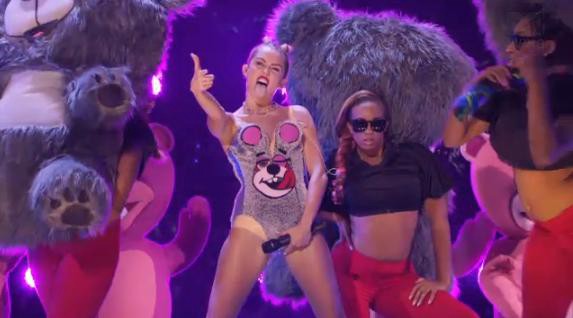
Miley Cyrus brought giant stuffed teddy bears and a foam finger to the VMAs this year. She stuck out her tongue indiscriminately, she slapped the asses of some anonymous black women, she stripped to her underwear and bent over in front of Robin Thicke, and and we all pondered again this ancient transition from “good girl” to pop vixen and wondered how we’re supposed to feel. What of this ephemeral existence — and why all the goddamn teddy bears?
Initially, watching the video for “We Can’t Stop,” I couldn’t decide if Miley was at all ironically self-aware; if she was conscious of the messages her reinvention was sending, of the way her studied makeover would make national news. This is our house, this is our rules, 20-year-old Miley sings, the grunge glam appeal of attractive teenagers destroying expensive things filling the screen behind her. And we can’t stop, and we won’t stop. She hasn’t: there was the haircut, then the twerking, and then this video, which was the fastest ever to be Vevo certified, and now the VMAs. She adopts Jamaican patois briefly as she proclaims her right to this new image. We run things, things don’t run we, we don’t take nothin’ from nobody.
Miley’s endless party reminds me of an earlier hit, the ubiquitous single by Icona Pop that’s successfully spanned two summers and appeared on Girls, on Glee, and in this Samsung Galaxy commercial. Both “I Love It” and “We Can’t Stop” feature young beautiful women flaunting a kind of hands-thrown-up wild enjoyment of life, their message simple and explicit: we’re young and having fun, we make our own rules.
What they’re referring to can mean as much or as little as the listener desires. One distinction between the not-caring of “I Love It” and the not-caring of “We Can’t Stop” is that Icona Pop’s lyrics seem spurred in part by a breakup, whereas Miley, in her transition from Disney darling to pop star, is just sharing some things she’s been thinking about lately — OK?
There have always been party anthems and forever will there be. Within this category, the Summer Party Anthem is its own subgenre (lest we forget, this isn’t Miley’s first). And popular music, broadly rooted in rock-and-roll, is itself based on a nonconformity that offers a perpetual middle-finger to the conventions of older generations. Decades ago, partying was a revolt in itself. But today’s corporate pop trades in images of over-the-top decadence as vaguely rebellious, shunting aside thoughts of actual critique.
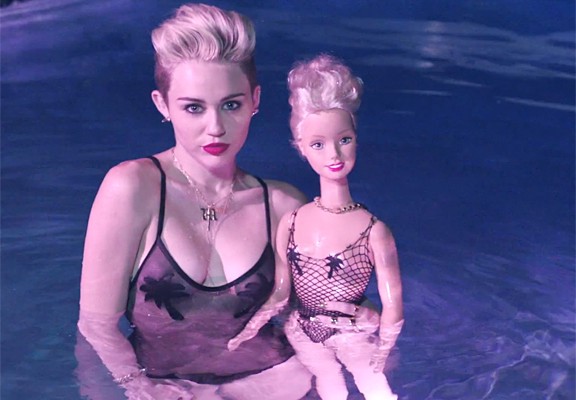
The aesthetic of “We Can’t Stop” draws on currently popular ’90s glam (Miley looks more Madonna and Gwen Stefani than Lady Gaga or Rihanna) while embracing the self-perpetuating nonsensical punchlines that define today’s commercials and memes. Hence the giant teddy bears strapped to backs (another molly reference?), the roasting of marshmallows by a lighter-candelabra, the taxidermied animals with sunglasses, and that weird pulsating cartoon face. There’s also a stylistic embrace of middle-Americana: a boy stuffs his face in a roomful of Wonderbread slices, sneakers stomp a skull made of fast-food fries. And of course, Miley’s drawing from hip hop, specifically of the Dirty Southern, bounce and crunk varieties. “Twerk” spelled out in Spaghetti-Os symbolically unites these the latter two influences.
As the video progresses, the festivities turn more destructive. Skinny-dipping and smoke flares become fighting and biting (Miley’s head gets graze-stomped by a sneakered foot) and piñata-destroying (it’s filled with Slim Jims? hot dogs?). Consider it the guitar-smashing-hotel-room-trashing of the pop star present.
In Retromania: Pop Culture’s Addiction to its Own Past, Simon Reynolds argues that while all culture is inevitably influenced by what came before, never has there been a society so interested in its immediate cultural past, or more able to access it instantaneously and comprehensively. Reynolds worries that all the referencing and recycling puts creativity in danger.
Miley was born in 1992. She was seven years old when we crossed over into the new millennium. But it’s safe to say that whatever she missed in consciousness, she was able to absorb thanks to VH1’s I Love the ’90s and all kinds of Internet nostalgia — not to mention, we can be sure, market-driven research and the guidance of the many baby-boomers behind the scenes of her empire. The prosperity and technological innovation of the ’90s makes the decade tempting for a new millennium of cultural producers influenced by the mega-popularized retro/vintage industry.
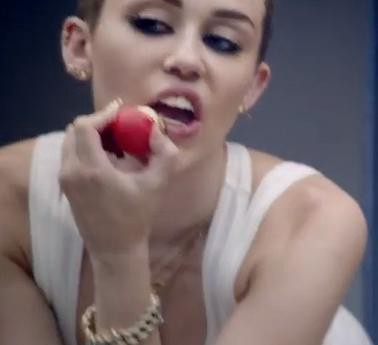
In “I Love It,” Icona Pop sings, you’re from the ’70s, but I’m a ’90s bitch. It’s clearly a diss to the nameless ‘70s-devotee. After the 2008 crash and following European crisis, do these hits signal the confluence of innovation apathy and nostalgia for our most recent decade of affluence? In the wake of the recession and alongside a major corporatization of the mass music industry, did we break completely from all notions of ’60s revolution — of the possibility for any real change — in favor of comfortable stability and the repurposing of decades past?
Rock critic Ellen Willis would say no. “What cultural revolutionaries do not seem to grasp,” she wrote in 1969, just after Woodstock, “is that, far from being a grass-roots art form that has been taken over by businessmen, rock itself comes from the commercial exploitation of blues. It is bourgeois at its core, a mass-produced commodity, dependent on advanced technology and therefore on the money controlled by those in power. Its rebelliousness does not imply specific political content; it can be — and has been — criminal, fascistic, and coolly individualistic as well as revolutionary.” Pop’s push-back has always been more stylish than ideological.
So, is Miley’s Rebellion a post-capitalist promotion of material luxury as the ultimate freedom? Should we worry that it’s a completely corporate-run show? Or, as we’re still blasting it secretly in our rooms, do we just not care and love it?
***
American hip hop’s been around since the late ’70s, but until the mid-late ’80s, the new genre was mostly unknown to Americans with no connection to the New York communities in which it was born. Kurtis Blow’s 1986 Sprite advertisement marks the transitioning of the genre into the commercial mainstream, where it has consolidated and stayed.
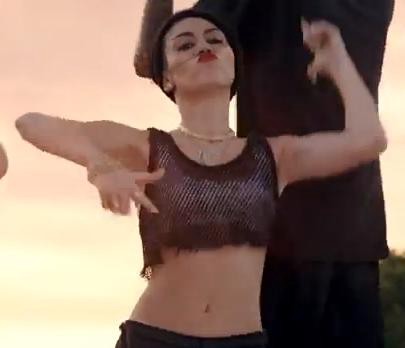
Reynolds identifies the most recent transformation of mainstreamed hip hop in the currently fashionable omnipop, a sound also rooted in ’80s electro and ’90s club music, meshing these three movements into a “high-fructose sound of brash, blaring excitement,” super-compressed and stream-ready. Ironically (or not: ask Miley), the boasting, toasting, signifying and flossing of early hip hop — born of particular economic and cultural circumstances, and oftentimes critical of larger systems of inequality: read Jeff Chang, Tricia Rose and others — now extends, bloated and bland, to this post-Disney mainstream.
Of course hip hop, and the early DJ culture it originates from, is itself based on sampling and recycling. Taking this too to an extreme, today’s omnipop — and, more broadly, pop culture generally — mirrors the way our economy is no longer based on production, but on speculation and manipulation of dematerialized value. This mishmosh of sound self-consciously performs early hip hop’s rebellion against mainstream American structures invested in — thriving on — inequality, while being itself carefully packaged by corporate interest. Miley’s Rebellion, then, performs tongue-in-cheek alienated consumerism for money, while pretending to be free.
***
Produced by Mike WiLL Made-It, “We Can’t Stop” was originally written for Rihanna, but when she passed in favor of “Pour It Up.” Next up was Miley. “We went in, she nailed the record, and she did it with her swag,” said Mike.
What is Miley’s particular swag? Visually: a grill, sported ODB-style, a whole lot of white spandex, and a lot of product placement. To my homegirls here with the big butts, Shaking it like we at a strip club, Remember only God can judge us, Forget the haters cause somebody loves ya, Miley sings, a reference to Tupac.
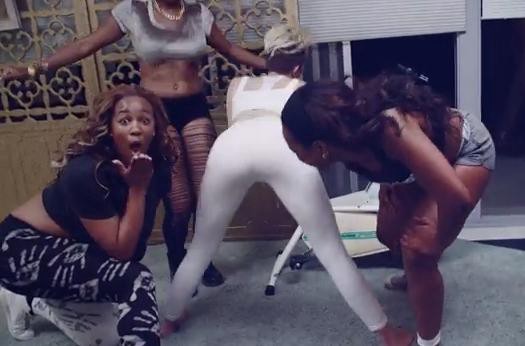
And then there’s the “swag” of her performance: the twerking and play-spanking with three black women, seemingly the only people above 23 in the video and replicated at her VMA performance too, a form of questionable human accessorizing reminiscent of Gwen Stefani’s Harajuku phase. It’s not that we should be surprised that Miley’s twerking, or that she’s spending time with these women, who could very well be her friends, sure. But there’s an important chasm between individual relationships and the larger corporate controlled pop culture image-making industry in which Miley’s immersed.
“Let’s not get it twisted,” Dodai Stewart explains, “The exchange and flow of ideas between cultures can be a beautiful thing. I believe in cross-pollination and being inspired by those whose experience is not like your own. If Miley is inspired by gold teeth and bounce music and has friends who are rappers, that’s not a problem.” Snoop Dogg/Lion is a known supporter and friend (Miley appears on his latest reggae album) as are members of Odd Future, and Pharrell, Ludacris, Big Sean, and Juicy J are featured on her upcoming album.
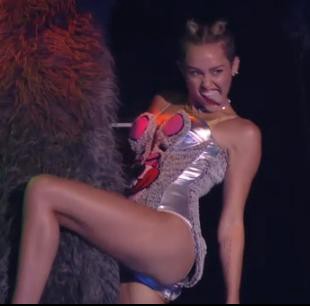
“But when she uses these things to re-style her own image, she veers into dangerous territory,” Stewart continues. Hip hop originated in low-income and, not by accident, black and brown communities. This particular example of trying on stylistic aspects of a culture not your own brings into clarity the very real optical illusion of the ties between race and class in America. Such conversations spurred by the Harlem Shake controversy reached the mainstream earlier this year.
Specific to the entertainment industry, it’s worth considering the purpose and results of a star like Miley adopting certain cultural signifiers. How styles and now-mass-produced trends — specifically, in this case, those originally born of hip hop — can be used, in what ways, and for whose benefit. It’s a complex question of how certain financial-material realities — in this national case, and often, inseparable from race and ethnicity — create culture born of these realities.
A famous young white woman donning a non-Anglo style garners a different reaction than would a famous young black woman (say, Ciara) wearing a grill and twerking — not to mention a non-famous person associated with the culture in question. Miley may know what she’s doing in terms of parlaying her image into media hysterics, but she seems to have no idea of the importance of knowing the legacy of what you wear or do; of how signifiers shift over time; of corporate control and material consequence; of individual intent and contextual history. As Katie Ryder writes, “If we only welcome difference when it’s on the bill — a rap show, a queer night at a club — or when we imitate it, whiten it and straighten it, but don’t want it as a part of our regular space, we don’t really welcome it at all.” Appropriation as deliberate corporate image-making — that’s another form of unwelcome altogether.
***
In the passage to sexy, white female pop stars of the last couple decades often appropriate the work of black, male hip hop artists. On her own breakout album, Selena Gomez, another Disney-to-pop-star, has updated Buju Banton’s 1995 dancehall classic “Champion.” Picture for a moment Miley and Selena getting hyped in the mirror, preparing to face the haters head on: Stand up let em know that you shine bright, Throw down let em know that you got fight, Selena sings, And show ’em that you’ve never felt so sexy, sexy, sexy. Icona Pop’s other song repurposes Jay Z and Beyonce’s “Bonnie & Clyde” (which itself repurposes Tupac’s original “Me and My Girlfriend”). Ke$ha’s oeuvre is another example in itself, and, before them all, following her transition from not-a-girl to not-yet-a-woman, Britney Spears notably reminded us, looking to Bobby Brown, that it was her prerogative.
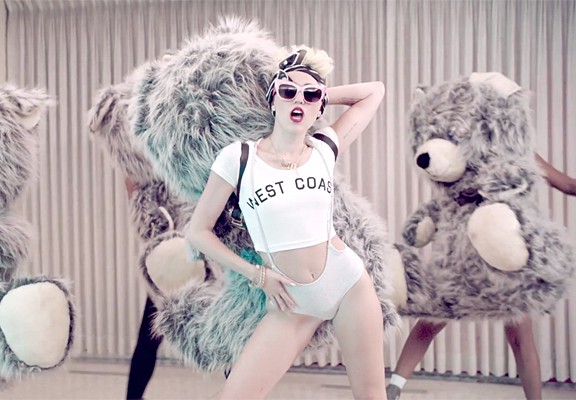
The forceful confidence of hip hop (and its trope of dismissing the “haters”) is reinterpreted by these over-scrutinized starlets as female empowerment on the defense. It converts what can be perceived as threatening black male aggression into a celebratory shield of sexuality and self-determination to be used during their public coming-of-age. This is a messy site of artist autonomy and corporate control. “I did my time, like I did what I was supposed to do,” Miley told Hot 97 of her years as Hannah Montana, “and now I’m at a point where I can just do things because I love it, not because I’ve gotta build this fan base or I’ve gotta make this money.”
“I don’t think people have a hard time understanding that I’ve grown up,” Miley told the New York Daily News in another interview. “I just think the world is so lame because you can shoot people in a movie and you can let people like [George] Zimmerman off on trial,” she continued, frustrated about the UK censorship of her video, “but you can’t have someone going like this [Cyrus simulates oral sex gesture].”
The reaction to “We Can’t Stop” is no great injustice, but Miley’s frustration is real. The world doesn’t make sense sometimes; political engagement is at an all time low while inequality is at a high; Stand Your Ground law and culture — just the most recent and most public example of a racialized and violent criminal justice system — is tragic: even, in the vernacular of Miley’s contemporaries, lame. A 20-year-old might easily react to the world’s injustices with a shrug, an oral sex gesture, and some molly; she might also do better to more explicitly recognize the vast difference in our country between an image of Trayvon wearing a grill (the stuff of courtroom “evidence”) and a VMA-nominated white woman trying one on for show.
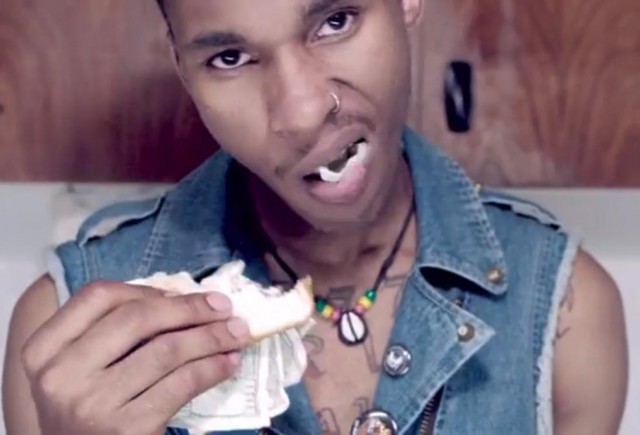
On his new album, Jay Z describes old money disdain for “new blacks with new stacks,” new money that can buy out “blue bloods” in their own neighborhoods. You can turn up your nose high society, he says, Never gone turn down the homie. The track, “Somewhere in America,” is brief, and concludes with a teasing nod to Miley: Feds still lurking, They see I’m still putting work in, Cause somewhere in America, Miley Cyrus is still twerkin’, trailing off in the refrain, Twerk, Miley, twerk… and a high-pitched laugh.
It’s social commentary that simply conveys the complexity of the interplay between race, class, and culture in our country, and the ridiculousness of what sometimes follows. There’s no way of knowing what Miley really thinks, besides her pride for the shout-out as part of the “new world order.” As with most celebrity, it’s near impossible to distinguish between Miley the twenty-year-old and Miley the lucrative image. But no matter what’s real and what’s for sale, “We Can’t Stop” speaks to a current mood and moment, where the two are perhaps less and less distinguishable. Only in America.
Previously: My Long-Lost Cousin the Vampire: A Not-So-Philosophical Search for Ezra Koenig
Lucy McKeon is a New York–based writer and photographer. Her work has appeared in The Nation, The Boston Review, Guernica, The Paris Review and elsewhere.